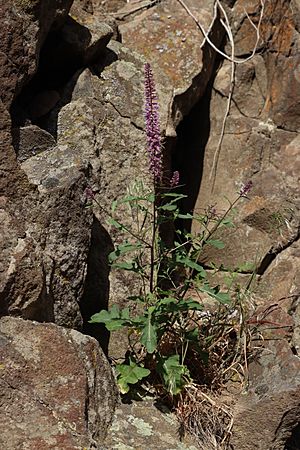Cutleaf thelypody facts for kids
Quick facts for kids Cutleaf thelypody |
|
|---|---|
 |
|
| Scientific classification | |
| Genus: |
Thelypodium
|
| Species: |
laciniatum
|
Thelypodium laciniatum is a type of flowering plant that belongs to the mustard family. People often call it the cutleaf thelypody.
You can find this plant growing naturally in western North America. It especially likes dry, rocky places like cliffs and hillsides. It often grows among sagebrush and other scrub plants, usually below 8,000 feet (about 2,438 meters) in elevation. It is common in the Great Basin area.
About the Cutleaf Thelypody
Thelypodium laciniatum is a plant that lives for two years. This means it grows leaves in its first year and then flowers, produces seeds, and dies in its second year. It grows many straight stems that can be taller than one meter (about 3 feet).
Stems and Leaves
The stems of this plant are smooth and don't have any hairs. They are also solid and often feel a bit waxy.
The leaves at the bottom of the plant are thick and green. They are divided into several parts that look like spear tips. Leaves higher up on the plant are smaller and not as divided.
Flowers and Fruits
The plant produces a large group of flowers called an inflorescence. This group looks like a dense, spiky cluster of mustard-like flowers. The petals are usually whitish or a light lavender color.
After the flowers bloom, they turn into fruits. These fruits are long and narrow, shaped like cylinders. They can be up to 10 to 14 centimeters (about 4 to 5.5 inches) long. These fruits are called siliques. When the plant is full of fruit, the siliques cover the flower cluster. They often curve or stick straight out, looking a bit like whiskers.

